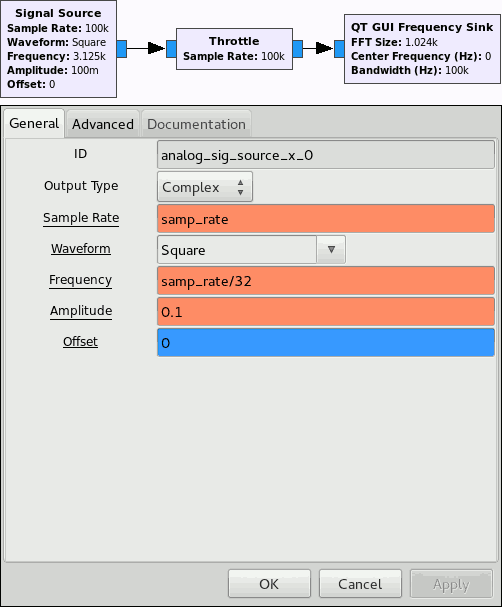I don't know what frequency f_squarewave your square wave has, but rectangular signals have sinc-shaped envelope, with peaks every f_squarewave.
Having a sinc envelope especially means it exists over the whole nyquist band -- so that explains why you see your complete spectrum rise!
I think what you should do is have a look at the spectrum of your transmit signal. This will make it easier to understand what you see at the receiver.
Try this: http://i.imgur.com/EARpJLx.png

so, a squarewave with frequency of f_sample/32 (remember, there's no real frequencies in DSP -- this really just tells GNU Radio that a period is 32 samples long).
Important: the QT sink is set to have an FFT length of 1024 points.
You should see this: http://i.imgur.com/33xrCl6.png
Now, if you have a look at this spectrum, you'll notice deep "wells" between the peaks, which aren't there in the receive PSD, right?
There's a simple reason for that: In the simulation / the TX spectrum, your f_squarewave is probably an integer factor of f_sample. This means that the period is a whole number of samples, and that whole number of samples also happens to be an integer factor of your FFT length! Therefore, your signal is perfectly periodic (as far as the observer can tell), and hence, has line spectrum characteristics.
Now, we'll play around with the frequency of the square wave:
http://imgur.com/Kduv5fL
set it to f_sample/32/2**0.5 ; the root of 2 is not a rational number, so no FFT window in this world could transform this without leakage. So you get this:
http://imgur.com/1Fkl8f8
Looking familiar?
Now, these are extremes. But the problem here is that frequency synchronization between your N210 and B200 will not be perfect -- hence, on the receiver side, the signal period might not be as exactly the integer factor that you have on the TX side, and you see the inter-peak leakage.
I hope that has explained the most of this phenomenom.
Best regards,
Marcus
On 22.07.2015 20:40, Ashraf Younis
wrote:
---------- Forwarded message ----------
From: Ashraf Younis <address@hidden>
Date: Wed, Jul 22, 2015 at 2:39 PM
Subject: Re: [Discuss-gnuradio] Creating a FFT plot like the one in this youtube variable
To: Marcus Müller <address@hidden>
I apologize for the way it seems I'm relaying information. I will attempt to give you all new information with your perspective in mind.
I have two screenshots now, they have a fixed y-axis from 0 to -100 dB. The first is the graph that is displayed when there is no signal transmitted and the second is when there is one being transmitted. From the screenshots it is evident that the signal raises all of the graph's values, instead of where the signal is being transmitted. The receiving gain is set to 1. I deleted the bandwidth QT GUI Entry since my I did not know what it was doing. The receiver is is a USRP B200
The signal I am transmitting on the USRP 2921 is a simply square wave. the IQ rate is 100k, the antenna is a vert 2450 dual-band, it is set to 10 gain. It was transmitting in the same channel the B200 is receiving.
I just want to make sure we're headed in the right direction. I want to use a wide band spectrum sense graph
On Wed, Jul 22, 2015 at 1:55 PM, Marcus Müller <address@hidden> wrote:
sure :)
On 22.07.2015 19:45, Ashraf Younis wrote:
Excuse me, it was my mistake.I sent it as an attachment, is that okay?
On Wed, Jul 22, 2015 at 1:29 PM, Marcus Müller <address@hidden> wrote:
Hi Ashraf,
your mail is only 8.5kB large -- did you possibly forgot to include links to the images?
Best regards,
Marcus
On 22.07.2015 19:28, Ashraf Younis wrote:
Thank you for replying.I included some screenshots of the program. One is of the block diagram and the other is of the graph itself.I am generating a signal using a different device and program. having only one B200 has prompted me to use this method. I am using a NI USRP-2920 with lab view to generate a signal
On Wed, Jul 22, 2015 at 12:01 PM, Marcus Müller <address@hidden> wrote:
Hi Ashraf,
If you've configured the USRP source correctly, you're very likely actually displaying the spectrum your digital receiver sees -- depending on the signal, you could a) actually be rising the power level in that whole band, or b) maybe you're observing something like saturation and hence intermodulation of additional signals.
You migth want to share what exactly you are observing, and what exactly the signal is you're generating. Screenshots are easy to make and to upload [1], so please illustrate a little better!
Best regards,
Marcus
[1] www.imgur.com
On 22.07.2015 17:56, Ashraf Younis wrote:
Hello, the issue I am having is I cannot display a graph that shows a wide range of frequencies and their power. When I attempt it with the QT GUI Frequency in GRC, I get something similar to the one in this video (FFT plot) but then I transmit a signal in the range I am currently looking at and the whole line moves up. This leads me to believe that I am no displaying the whole range I desire, but in fact I am displaying the center frequency and a small bandwidth around it. I want to, for example, scan the 2.4 GHz range and see all of the channels and their power. And when I transmit at a certain frequency, I see a spike at the spot in the graph.
How do I create that graph?
_______________________________________________ Discuss-gnuradio mailing list address@hidden https://lists.gnu.org/mailman/listinfo/discuss-gnuradio
_______________________________________________
Discuss-gnuradio mailing list
address@hidden
https://lists.gnu.org/mailman/listinfo/discuss-gnuradio
_______________________________________________ Discuss-gnuradio mailing list address@hidden https://lists.gnu.org/mailman/listinfo/discuss-gnuradio